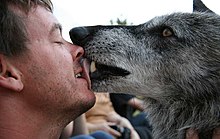
The coyote is a species of canine native to North America. It is smaller than its close relative, the wolf, and slightly smaller than the closely related eastern wolf and red wolf. It fills much of the same ecological niche as the golden jackal does in Eurasia. The coyote is larger and more predatory and was once referred to as the American jackal by a behavioral ecologist. Other historical names for the species include the prairie wolf and the brush wolf.

The wolf, also known as the gray wolf or grey wolf, is a large canine native to Eurasia and North America. More than thirty subspecies of Canis lupus have been recognized, including the dog and dingo, though gray wolves, as popularly understood, only comprise naturally-occurring wild subspecies. The wolf is the largest extant member of the family Canidae, and is further distinguished from other Canis species by its less pointed ears and muzzle, as well as a shorter torso and a longer tail. The wolf is nonetheless related closely enough to smaller Canis species, such as the coyote and the golden jackal, to produce fertile hybrids with them. The wolf's fur is usually mottled white, brown, gray, and black, although subspecies in the arctic region may be nearly all white.

The dingo is an ancient (basal) lineage of dog found in Australia. Its taxonomic classification is debated as indicated by the variety of scientific names presently applied in different publications. It is variously considered a form of domestic dog not warranting recognition as a subspecies, a subspecies of dog or wolf, or a full species in its own right.

A wolfdog is a canine produced by the mating of a domestic dog with a gray wolf, eastern wolf, red wolf, or Ethiopian wolf to produce a hybrid.

White Fang is a novel by American author Jack London (1876–1916) — and the name of the book's eponymous character, a wild wolfdog. First serialized in Outing magazine between May and October 1906, it was published in book form in October 1906. The story details White Fang's journey to domestication in Yukon Territory and the Northwest Territories during the 1890s Klondike Gold Rush. It is a companion novel to London's best-known work, The Call of the Wild (1903), which is about a kidnapped, domesticated dog embracing his wild ancestry to survive and thrive in the wild.

White Fang is a 1991 American Northern period adventure drama film directed by Randal Kleiser, starring Ethan Hawke, Klaus Maria Brandauer and Seymour Cassel. Based on Jack London's 1906 novel White Fang, it tells the story of the friendship between a young Klondike gold prospector and a wolfdog. White Fang is portrayed by a wolfdog, Jed, who also appeared in such films as The Thing (1982) and The Journey of Natty Gann (1985). The film was released on January 18, 1991, by Buena Vista Pictures. A sequel to the film, White Fang 2: Myth of the White Wolf, was released in 1994.

A coydog is a canid hybrid resulting from a mating between a male coyote and a female dog. Hybrids of both sexes are fertile and can be successfully bred through for generations. Similarly, a dogote is a hybrid with a dog father and a coyote mother.

Coywolf is an informal term for a canid hybrid descended from coyotes, eastern wolves, gray wolves, and dogs. All members of the genus Canis are closely genetically related with 78 chromosomes and therefore can interbreed. One genetic study indicates that these two species genetically diverged relatively recently. Genomic studies indicate that nearly all North American gray wolf populations possess some degree of admixture with coyotes following a geographic cline, with the lowest levels occurring in Alaska, and the highest in Ontario and Quebec, as well as Atlantic Canada. Another term for these hybrids is sometimes wolfote.
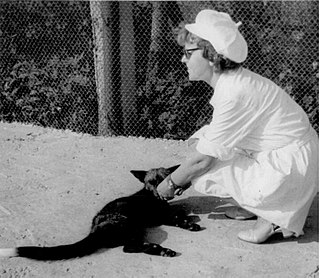
The domesticated silver fox is a form of the silver fox that has been to some extent domesticated under laboratory conditions. The silver fox is a melanistic form of the wild red fox. Domesticated silver foxes are the result of an experiment designed to demonstrate the power of selective breeding to transform species, as described by Charles Darwin in On the Origin of Species. The experiment at the Institute of Cytology and Genetics in Novosibirsk, Siberia explored whether selection for behaviour rather than morphology may have been the process that had produced dogs from wolves, by recording the changes in foxes when in each generation only the most tame foxes were allowed to breed. Many of the descendant foxes became both tamer and more dog-like in morphology, including displaying mottled- or spotted-coloured fur.

The domestication of animals is the mutual relationship between non-human animals and the humans who have influence on their care and reproduction.

A pack is a social group of conspecific canines. Packs aren't formed by all canines, especially small sized canines like the Red fox. The number of members in a pack and their social behavior varies from species to species. Social structure is very important in a pack. Every pack member will have a position and a role to play. Canine packs are led by a breeding pair, consisting of the alpha male and the alpha female.
Canid hybrids are the result of interbreeding between the species of the genus Canis. This often occurs in the wild, and in particular between domestic or feral dogs with wild native canids.

The CzechoslovakianWolfdog is a wolf-dog breed that began as an experiment conducted in Czechoslovakia in 1955.

Dog behavior is the internally coordinated responses of individuals or groups of domestic dogs to internal and external stimuli. It has been shaped by millennia of contact with humans and their lifestyles. As a result of this physical and social evolution, dogs have acquired the ability to understand and communicate with humans, and they are uniquely attuned in these fellow mammals. Behavioral scientists have uncovered a wide range of social-cognitive abilities in domestic dogs.
Wild Spirit Wolf Sanctuary (WSWS) is an animal sanctuary in Candy Kitchen, New Mexico, United States, dedicated to rescuing and providing sanctuary for captive-bred wolves and wolfdogs. It is a 501(c)(3) non-profit organization.
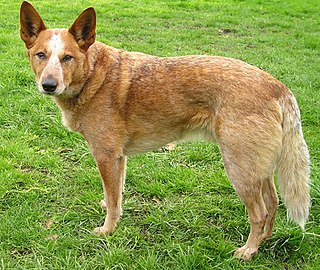
A dingo–dog hybrid is a hybrid cross between a dingo and a domestic dog. The current population of free ranging domestic dogs in Australia is now probably higher than in the past. However, the proportion of the so-called "pure" dingoes has been on the decrease over the last few decades due to hybridisation and is regarded as further decreasing.

A free-ranging dog is a dog that is not confined to a yard or house. Free-ranging dogs include street dogs, village dogs, stray dogs, feral dogs, etc., and may be owned or unowned. The global dog population is estimated to be 900 million, of which around 20% are regarded as owned pets and therefore restrained.
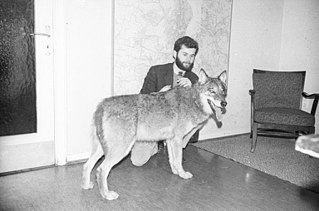
Erik Zimen (1941-2003) was a Swedish behavioral scientist. He specialized in the behaviour of wolves and dogs, carrying out his research in Bavarian forests and the Parco Nazionale d'Abruzzo, Lazio e Molise, Italy. He is best known for his book The Wolf.

A jackal–dog hybrid is a canid hybrid resulting from a mating between a domestic dog and a golden jackal. Such crossbreeding has occurred numerous times in captivity and was first confirmed to occasionally happen in the wild in Croatia in 2015.
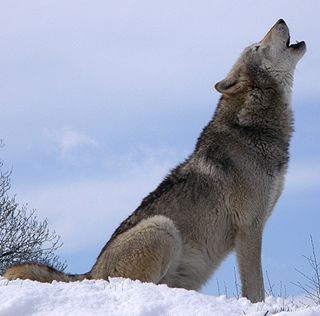
Howling is a vocal form of animal communication seen in most canines, particularly wolves, coyotes, foxes, and dogs, as well as cats and some species of monkeys. Howls are lengthy sustained sounds, loud and audible over long distances, often with some variation in pitch over the length of the sound. Howling is generally used by animals that engage in this behavior to signal their positions to one another, to call the pack to assemble, or to note their territory. The behavior is occasionally copied by humans, and has been noted to have varying degrees of significance in human culture.


